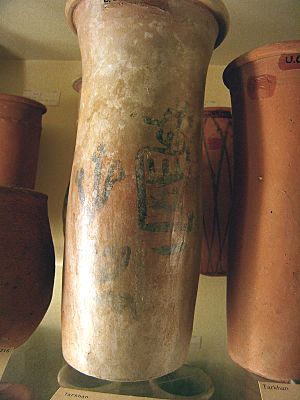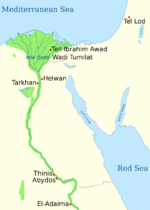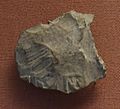Ka (pharaoh) facts for kids
Quick facts for kids Ka |
|
|---|---|
| Sekhen | |

Vessel found at Tarkhan bearing the serekh of King Ka. Petrie Museum, London
|
|
| Pharaoh | |
| Reign | 32nd century BC (Dynasty 0) |
| Predecessor | Iry-Hor |
| Successor | Scorpion II |
| Consort | Ha |
| Burial | Chambers B7, B9, Umm el-Qa'ab |
Ka, also known as Sekhen, was a very early pharaoh of Upper Egypt. He lived before the famous Egyptian dynasties began, during a time called Dynasty 0. He likely ruled in the early 32nd century BC, which is over 5,000 years ago! We don't know exactly how long he was king.
What's in a Name?
The exact way to read King Ka's name is a bit of a mystery. Ancient pots and objects show his name written inside a special symbol called a serekh. This symbol usually has a falcon god, Horus, on top.
Sometimes, the symbol for "Ka" is written normally. Other times, it's upside down! When it's upside down, some experts think it should be read as "Sekhen." This word means "to embrace someone."
Because of this puzzle, some historians simply call him "King Arms." It helps avoid confusion.
King Ka's Reign
King Ka ruled over an area called Thinis in ancient Egypt. He was buried in a place called Umm el-Qa'ab. He probably became king right after Iry-Hor. After Ka, either Narmer or Scorpion II took the throne.
King Ka is special because he is the earliest known Egyptian king to have his name written in a serekh on many items. This might mean he was the first to use this important symbol. He is one of the most well-known kings from this very early period, along with Narmer and Scorpion II.
Many objects with Ka's serekh have been found. They show up not just in his burial place, but also in other parts of Upper Egypt. They have even been found as far north as Tel Lod, which is in a different country today. Finding so many items far from his home suggests that King Ka's power and influence were growing. He might have even taken control of more parts of Egypt.
King Ka's Tomb
King Ka's tomb is made up of two underground rooms, called B7 and B9. They are located in the Umm el-Qa'ab burial ground in Abydos. Each room is about 1.90 meters deep. Room B7 is 6.0 by 3.2 meters, and B9 is slightly smaller. The two rooms are about 1.80 meters apart.
An archaeologist named Flinders Petrie first explored Ka's tomb in 1902. Inside, he found pieces of flint knives and pottery. In the southern room, B7, more than forty writings were discovered. These were on tall jars and cylinder-shaped pots. A special seal impression was also found.
Ka's tomb (B7, B9) is very close to the tombs of Iry-Hor and Narmer. This closeness, and the order of the tombs, suggests that Ka ruled after Iry-Hor and before Narmer. This helps historians understand the order of these early kings.
One cylinder jar found in the tomb has Ka's name on it. It also has the name "Ha, wife of the Horus Ka." This tells us that King Ka had a wife named Ha.
Images for kids
-
Vessel from Ka's tomb in Abydos bearing Ka's serekh on display at the British Museum.
-
Seal impression with Ka's serekh. Note the absence of the Horus falcon. British Museum.
-
Shard bearing Ka's serekh from his tomb in Abydos.
See also
 In Spanish: Horus Ka para niños
In Spanish: Horus Ka para niños









